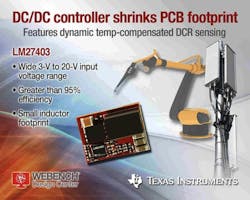Analog DC/DC Controller With Dynamic Temperature-Compensated Inductor Current Sensing
An analog DC/DC step-down controller from Texas Instruments introduced has remote bipolar junction transistor (BJT) temperature-compensated inductor current sensing that minimizes total solution footprint in high-power POL conversion. The 20-V LM27403 DC/DC synchronous buck controller provides greater than 95-percent efficiency from a 12-V input at 25 A of output current to optimize solution size and deliver fast transient response in communications infrastructure, industrial, medical and power module applications. Used in conjunction with TI's award-winning WEBENCH® online design tool, the LM27403 simplifies DC/DC conversion and speeds the design process. The temperature-compensated inductor DC resistance sensing improves the current limit accuracy to 10 percent over temperature by using a low-cost BJT to measure real-time temperature shifts, allowing the LM27403 to maintain a consistent current limit threshold across the operating temperature range. The current limit accuracy over temperature results in a smaller DC/DC converter footprint that reduces inductor over-design and allows for the use of smaller and lower-cost inductors. Watch a video demonstration of temperature-compensated inductor current sensing here.
The LM27403 provides a complete dynamic voltage solution when designed together with TI's LM10011 voltage identification (VID) interface controller and 30-V CSD87350Q5D synchronous buck NexFET™ Power Block MOSFET to adjust the core voltage (VCORE) of a VID-enabled processor, such as TI's TMS320C6000™ power-optimized DSPs and KeyStone™ based multicore DSPs.
Features:
· Wide 3-V to 20-V input voltage range converts 3.3-V, 5-V and 12-V input voltage rails to point-of-load (POL) as low as 0.6 V with one-percent accuracy.
· 30-ns minimum on-time allows higher switching frequencies at lower duty cycles, providing greater scalability and smaller solution size.
· 15-ns adaptive dead-time control provides higher efficiency in high frequency operation, reducing power consumption. Download the regulator design tool here.
· Output voltage remote sensing gives improved load regulation in high current applications.
The LM27403 synchronous buck controller is available in volume now from TI and its authorized distributors. Offered in a 4-mm by 4-mm by 0.8-mm, 24-pin PowerPad™ WQFN package, the controller is priced at US$1.20 in 1,000-unit quantities.
